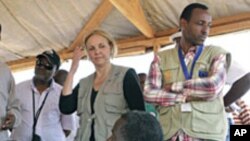The U.N. World Food Program has begun an airlift of emergency food aid to Somalia. Reports say that 10 tons of food were delivered in Mogadishu today. Earlier plans were delayed due to logistical problems in Kenya. The WFP director Josette Sheeran, who just returned to Rome after visiting the region, said the planes will deliver goods first to Somalia’s capital Mogadishu, and in coming days to other parts of the drought-stricken Horn of Africa.
It’s the first airlift of food since the U.N. declared a famine in two parts of Somalia last week. Sheeran said the WFP is considering every option to reach more than two million people who are currently inaccessible inside southern Somalia.
|
Definition of Famine: The word famine is a term that is not used lightly by humanitarian organizations. The United Nations describes a crisis as a famine only when the following conditions are met:
Current Famine:
|
The United Nations said “massive” action is needed to save millions of people in the Horn of Africa from starvation. Sheeran said she has just received pledges of $50 million in food aid from the king of Saudi Arabia. Millions more have been pledged by other countries.
A donor meeting is scheduled to take place in Nairobi Wednesday morning, with the U.N. calling for up to $1.6 billion to help the millions of malnourished people – many of them children.
During her trip to Mogadishu last week, Sheeran saw firsthand the plight of women and children, many of whom die before reaching the camps.
“I saw large numbers of children extremely weakened by the long journeys in search of food,” she said.
There are eyewitness accounts of people having to leave family members along the road as they trek on alone in search of help. “I spoke to this one woman,” said Sheeran, “who had lost three of her children along the way… trying to reach food.”
In Somalia, described as the “epicenter of the famine,” around one-third of the population is facing starvation. The WFP is mobilizing its resources from around the world to mount its response.
“We are bringing in stocks that we had in Pakistan for the floods,” she said. “We are ramping up production lines.”
Sheeran said children are the most vulnerable and that “we feel we have an urgent need to get special nutritious food to as many children as possible.”
But access to areas in need is still hampered by the al-Qaida-linked militant group al-Shabab, which controls much of the Somalia’s south. The group has rejected the U.N. declaration of famine in parts of Somalia, and has banned many aid groups from operating in territory under its control.
|
At the Dagahaley refugee camp in Dadaab, Kenya, families fleeing the famine in Somalia are given aid, but also face new challenges. VOA's Michael Onyiego visited the camp and took these pictures. |















